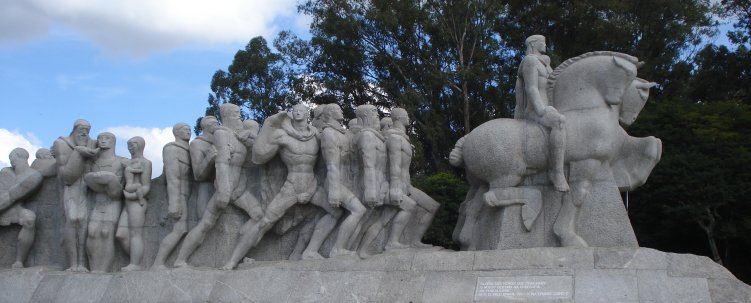Bandeirantes were members of bandeiras, or roving bands of explorers, prospectors, and Indian slavers originating principally in the frontier settlement of São Paulo in colonial Brazil, beginning around the 1580s and continuing for the next 150 years or so.
The original meaning of the term bandeira was “flag,” though in medieval Portugal it also came to mean a small autonomous militia. Their primary purpose was to acquire Indian slaves for their Paulista (São Paulo) patrons. Some bandeiras were gone years at a time and traveled thousands of kilometers through the back country.
In the process, the bandeirantes explored much of the vast Brazilian interior—its forests, grasslands, rivers, jungles, and backlands (sertão) to the west, south, and north—pushing back the colony’s known frontiers and opening up new paths for settlement and colonization.
  |
In Brazilian historiography and national culture, bandeirantes occupy a very important and highly ambiguous position—praised for their endurance and discoveries, and condemned for their brutalities and cruelties that were integral to Indian slaving in the backcountry.
By 1600, most residents of São Paulo (which at the time was a small settlement of only about 120 houses and 2,000 people) were Portuguese, Indian, and racially mixed mamelucos (the Portuguese equivalent of the Spanish term mestizo).
The predominant language was Tupí. Their city and homesteads vulnerable to attack, Paulistas initially launched bandeiras as a defensive measure against hostile natives. By around 1600, bandeiras had transformed into offensive slave-raiding expeditions.
The indigenous inhabitants around São Paulo having all but disappeared by this time, victims to enslavement and diseases, the Paulistas found them-selves chronically short of servile labor. The bandeiras were their effort to remedy this chronic labor shortage.
 |
| Bandeirantes monument in Sao Paulo Brazil |
Most bandeiras left no written record, though many others did, thanks in large part to Jesuit missionaries or foreigners who accompanied them through the backcountry and reported on their experiences. As one Jesuit priest marveled, “One is astounded by the boldness and impertinence with which, at such great cost, men allow themselves to enter that great sertão for two, three, four or more years.
They go without God, without food, naked as the savages, and subject to all the persecutions and miseries in the world. Men venture for two or three hundred leagues into the sertão, serving the devil with such amazing martyrdom, in order to trade or steal slaves.”
A classic account is by the Jesuit priest Pedro Domingues of 1613, which described a journey of several thousand kilometers lasting 19 months. Occasionally clashing with Spanish settlements emanating out from the Río de la Plata, the bandeirantes helped to define colonial Brazil’s southern boundaries.
   |
As time went on, they also clashed repeatedly with the Jesuits, who saw their slave raiding as antithetical to their own goal of converting the natives to Christianity and saving souls. This conflict between bandeirantes and Jesuits in colonial Brazil can be aptly compared to similar conflicts between encomenderos and religious missions in colonial Spanish America during this same period.
By around 1650, there occurred a broad shift among bandeiras from slave raiding to the search for precious metals. By this time, African slaves were fulfilling the colony’s servile labor requirements, while the Jesuit missions had fortified their defenses, making Indian slaving more difficult.
Greatly extending geographic knowledge of the vast Brazilian interior, the bandeirantes have come to occupy a position within Brazilian national culture akin to the cowboys of the United States or the gauchos of Argentina, symbolizing the spirit of adventure, independence, and, ironically, freedom. It is estimated that bandeirantes enslaved and caused the premature deaths of hundreds of thousands of Indians during the decades of their greatest activity.
